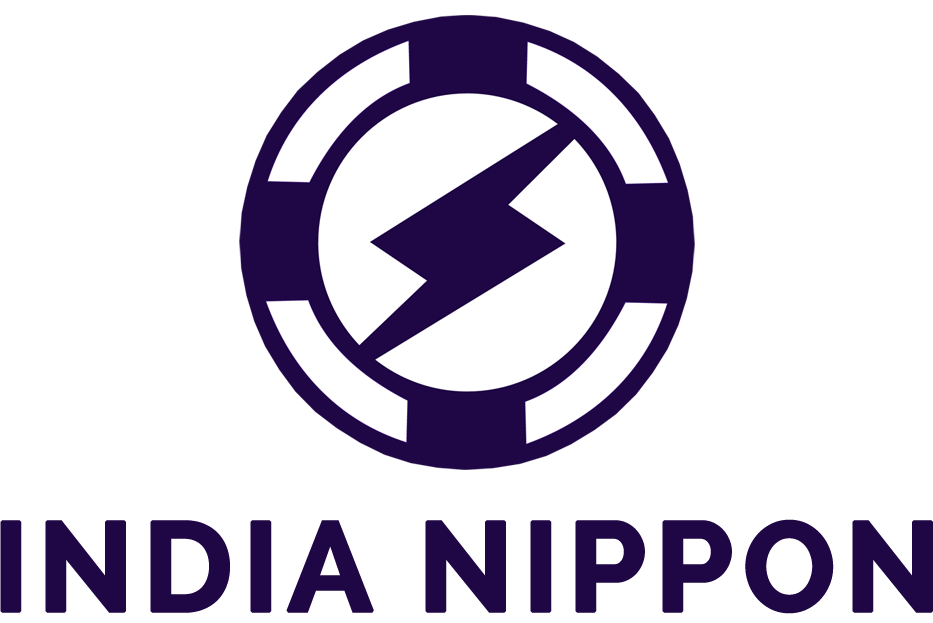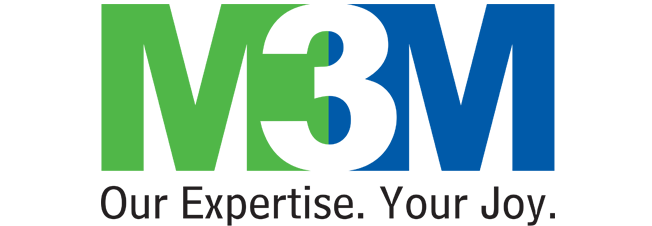Procol • October 10, 2025
Explore the complete guide to eprocurement technologies
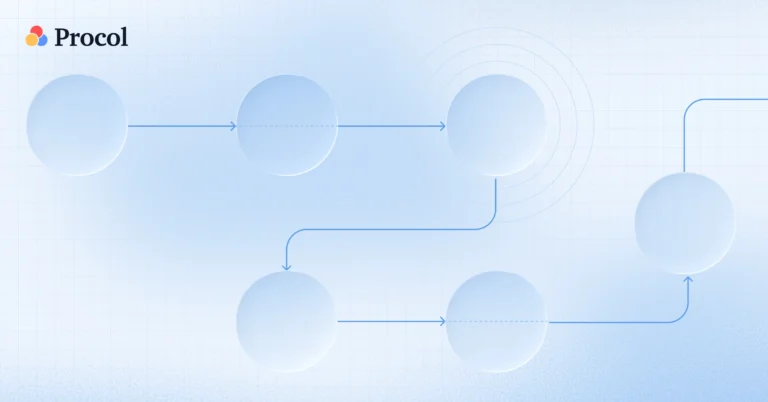
You might be thinking: placing one order for your company can’t be that hard, right? Spreadsheets keep your line items organized, and emails are easy enough to scroll through. But what if there was a solution that could get you results much faster? Here’s where eProcurement shines. This automates the entire cycle, right from identifying your need to paying the supplier. Instead of running around multiple departments and sorting through spreadsheets, you can get things done in just a few clicks. E procurement technologies compare suppliers, submit bids, track approvals, and generate invoices automatically, replacing manual work with smart digital workflows. This blog will highlight the importance of digital procurement, explain how it works, the various components involved, and tell you the best modern e-procurement tool for all your needs.
What is eProcurement?
eProcurement, also known as electronic procurement, involves the use of online software and digital tools to buy goods and services for businesses. In other words, e-procurement is the centralized management of a company’s entire buying and sourcing operations through an electronic platform. The “e” stands for “electronic,” and it is sometimes called supplier exchange. This technology helps businesses manage requests, orders, and purchases automatically, which helps keep everything organized. Therefore, by automating tasks that were once manual and time-consuming, businesses use e-procurement technology to simplify the entire process and stay organized.
What is the traditional procurement process?
Traditional procurement refers to the process of procuring goods and services manually, relying heavily on papers, physical documents, multiple phone calls, emails, spreadsheets, and in-person meetings for negotiations, verification, and other management tasks. It can be time-consuming and prone to error, as it involves several manual stages that businesses typically perform.
How does eProcurement work?
E-procurement is a comprehensive process of getting goods, services, or work from other businesses to meet a company’s needs. The procure-to-pay process involves a strategy, which includes things like identifying needs, sourcing the right suppliers, negotiating and finalizing contracts, and managing supplier performance and relationships. If this process is done well, it results in the company getting the products they need easily and at the best prices.
1. Selecting the ideal vendors
Buyers identify and see whether potential vendors suit their needs or not. This can be done through online platforms. Also, features like e-auction help businesses get the best and most competitive pricing without the manual effort.
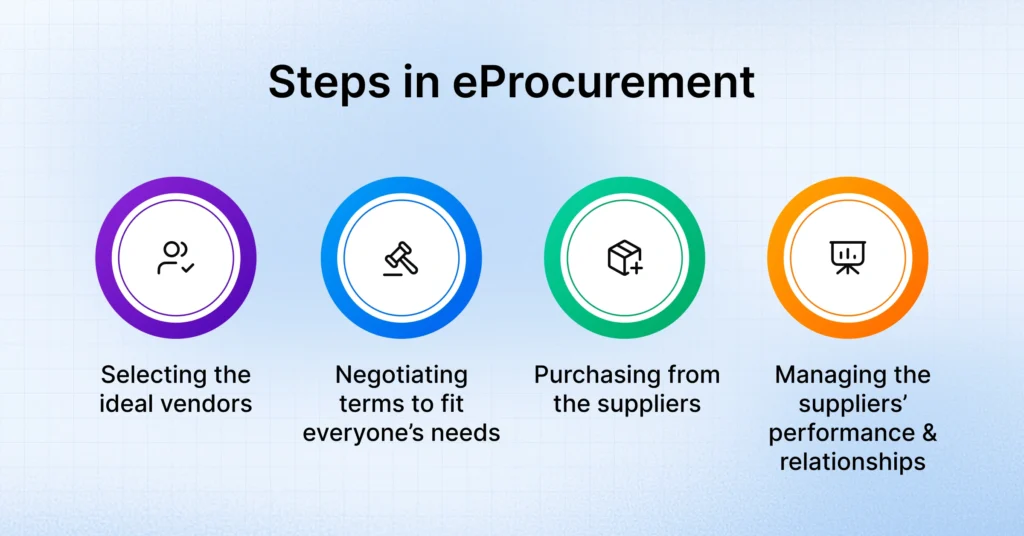
2. Negotiating terms to fit everyone’s needs
Suppliers submit bids online. Buyers can compare offers side by side, which helps them make smarter negotiations and faster decisions.
3. Purchasing from the suppliers
You can place orders directly through supplier catalogs. Additionally, approvals and the exchange of any digital data can be automated so that every interaction is accurate and secure.
4. Managing the suppliers’ performance and relationships
Post-purchase, companies track how the suppliers are performing using digital analytics, which cancels out the need for manual reviews. This helps in faster communication and more productive supplier relationships.
What are the core components of eProcurement?
E-procurement uses digital platforms to automate traditional procurement processes. This makes processes like sourcing, ordering, invoicing, and payment much easier and faster. This process covers all stages of the procurement process, so businesses can get the best deals without having to burn through their resources. Key features like online requests, RFQs, and bid submissions make that possible. Here are the key components.
1. E-informing
E-informing gathers and shares critical purchase data with all the internal teams directly connected with the sourcing process. It also keeps suppliers informed. Procurement teams then assess what each department requires and collate it into accurate and readable data that is sent to suppliers. Accurate data helps in a faster procurement cycle, especially when integrated with ERP systems.
2. Indent management
Indent management records and approves the internal requirement before the procurement process begins. Teams can create indents directly in the platform or pull them from ERP or EDI systems. Workflows ensure that only requests that have been accepted move to the next stage.
3. E-tendering
Online tendering digitizes the exchange of contract-related documents, such as product specifications and design instructions. It automates the creation, sharing, and tracking of tender documents, which reduces manual processes and the room for error. Digital platforms help both buyers and suppliers communicate on time and openly.
4. RFQ creation
Procurement teams generate RFQs and invite vendors to submit bids for the required goods or services. It includes detailed requirements, terms, and conditions. The platform often suggests matched suppliers based on their registered categories to make the process more targeted and efficient.
5. Bid/quote submission & evaluation
Vendors submit online bids or quotations in response to RFQs. It may include delivery timelines, price breakdowns, payment terms, and additional conditions. Buyers then evaluate all responses in a unified system, often through comparative statements, helping them quickly identify the best value offer.
6. Reverse auction
Reverse auctions allow vendors to reduce their prices in real-time to stand out. The online digital bidding process ensures greater competition, drives down procurement costs, and operates with complete transparency, allowing buyers to secure optimal pricing and terms.
7. Vendor selection & PO creation
Once the evaluation is complete, the platform helps you with vendor selection and automatically generates purchase orders. You can assign specific items to one or several vendors, and the platform sends POs directly to the chosen suppliers to start the contract initiation.
8. Vendor management
A good vendor management module allows your business to track supplier information, track performance, manage risk, and maintain healthy relationships. This helps supplier update their details whenever they need to, see any pending orders they need to fulfill, and see feedback given by buyers.
9. Catalog management
Catalog management ensures the product or service listings are correct, accessible, and updated. Digital catalogs enable the buyer to instantly compare products, prices, and terms, which improves the decision-making process.
10. E-purchasing
This is the process where buyers explore online catalogs of vendors, where they can select the products they want from a digital showroom. They can even place orders, make payments, and track delivery. This is usually done with items that the company purchases on a regular basis and aren’t of extremely high value.
11. E-ordering
This component manages the approval, processing, and tracking of purchase orders. Relevant employees gain access to the system, ensuring departments receive what they need while maintaining central oversight and compliance.
12. E-invoicing
It automates the process of generating invoices. It creates the invoices based on orders and sends them to the accounts that are payable, enabling prompt review and payment, all with a complete audit trail.
13. E-contract management
It helps in the creation, negotiation, approval, and storage of all the procurement contracts online. Businesses and suppliers can manage agreements online, track revisions, and ensure timely renewals, which leads to increased efficiency and lowered manual work.
14. E-communication
Throughout the online procurement journey, the automated e-communication keeps all your stakeholders informed and in the loop. This helps configure and deliver messages about approvals, submissions, and changes to ensure alignment and clarity for every involved party.
15. ERP integration
eProcurement tools connect easily with your company’s ERP system. This helps both systems work together without the need for manual intervention. It keeps everything up to date in real-time and helps teams make faster, more informed decisions.
What are some e-procurement tools?
The e-sourcing process uses digital tools to make buying easier. These tools come with many features that make the process more accurate, which speeds things up for businesses. These tools have many functions, like managing sourcing, ordering, contracts, and suppliers in one place, without having to use too many. Here are some key tools used in e-procurement.
1. Data exchange tools (EDI)
EDI lets companies send and receive data between systems. These tools automate processes like invoicing and ordering, so that it takes the manual load off the internal staff. Additionally, this software is completely secure and allows messages and updates to be shared securely between buyers and vendors.
2. Online procurement platforms
These platforms handle daily procurement tasks. They include e-sourcing, e-tendering, e-auctioning, and e-ordering tools. These platforms usually work off email and XML, so that this data can be shared with the respective people quickly.
3. Digital ordering and purchasing tools
Web-based ERP systems and digital auctions make it easy to place and track orders. Using this, buyers can compare products from different vendors, weigh prices, and assess suppliers from one platform.
4. All-in-one procurement software
This software is used for e-procurement and automates the entire sourcing process, allowing everyone involved to view all stages, like sourcing, buying, and paying, in a single platform. Tools like Procol help companies compare supplier offers, manage approval workflows, and customize processes without any coding knowledge.
5. Spend tracking tools
Spend management tools help businesses track how much money they are spending. It also helps plan budgets and ultimately, forecast the need for more goods in the future.
6. Contract handling tools
These tools manage supplier contracts from creation to renewal. They help companies track term changes, payments due, vendor performance, and compliance levels. These tools also send automated alerts so businesses don’t miss out on important deadlines.
7. Supplier management tools
These tools handle RFIs and RFPs online. Companies can use these to track supplier response rate, compare bid results, and support negotiations. They make supplier selection faster and fairer.
Who can use eProcurement?
eProcurement is useful in every sector. Whether you’re a big business, a school, a non-profit organization, a government company, or a small business just starting, digital procurement helps you make smarter buying decisions. Let’s see the different types of industries that benefit from e-procurement.
1. Healthcare and nonprofits
Hospitals, clinics, and nonprofits have to juggle large purchases daily. These include ordering medical equipment and IT systems, which need a very organized procurement system to manage everything. Digital procurement helps here by simplifying the ordering process for these facilities, and also helps them stay within their budget. Teams can still coordinate with one another easily and manage operations well.
Key priorities:
- Partner and collaborate with suppliers
- Improve cost efficiency while maintaining quality
- Increase the ability to handle high demand
- Focus on long-term benefits and planning
2. Government agencies
Government procurement involves being very mindful of compliance laws and ensuring all activities are carried out in accordance with public funds and government rules. eProcurement helps leaders review bids faster and compare offers from different suppliers. Additionally, they can also support local vendors and make the process faster and more transparent.
Key tools and priorities:
- E-tendering, E-contract management, spend control, E-auctions
- Digital marketplaces for the public sector support
- Job creation and skills development
- Supporting local economies and sustainability
- Increasing efficiency in procurement processes
3. Manufacturing and industry
Factories and industrial companies need supplies to be delivered to them in bulk. This means long lists and heavy requirements. The procurement of raw materials and machinery needs to be fast and systematic in order to maintain large-scale operations.
Key benefits:
- Digital procurement helps track market costs for goods and equipment
- Manage risks and demand fluctuations
- Maintain strong supplier relationships
4. Education (schools & universities)
Schools and universities need to balance budgets and also ensure supplies are delivered on time. Not to mention, remote and hybrid learning situations make the process more complex and increase the demand for goods.
Key priorities and tools:
- Platforms like Jaggaer for e-tendering
- Support for remote and hybrid learning
- Promote economic growth and improve educational standards
- Support affected and disadvantaged students and post-COVID recovery
5. Travel and hospitality
Hotels, airlines, and restaurants must meet customer expectations. They also have the additional demand to keep their costs under control, operate according to environmental laws, and ensure their practices are sustainable.
Key benefits:
- Find the right suppliers quickly
- Control operational costs
- Maintain eco-friendly and sustainable practices
6. Commercial businesses
Commercial businesses like shops, cafes, and offices can’t compromise on the quality of their products or services. They also have to balance and adjust to changes like economic instability and remote work.
Key priorities:
- Streamline purchase processes
- Make supply chains more diverse
- Support sustainability and local suppliers
- Adapt to remote/hybrid work trends
7. Corporations and enterprises
Large companies handle thousands of orders daily. This means that everything, like catalogs, invoices, and approvals, needs to be managed well, and there should be little to no errors in these processes.
Key benefits:
- Centralize procurement processes
- Reduce manual errors
- Free teams to focus on growth
8. Logistics and supply chain
Shipping and logistics firms rely on smooth coordination and on-time deliveries. E-procurement supports them in tracking the entire procurement process, right from packing orders to vendor performance.
Key benefits:
- Track orders efficiently
- Control shipping and packing costs
- Manage suppliers reliably
- Ensure streamlined operations
What are the challenges of e-procurement technology?
E-procurement transforms the whole buying process and makes it smarter, but it comes with its own set of challenges that businesses should consider before using digital sourcing. It can be hard to implement this technology, expensive to maintain it, difficult to get staff adapted to it, and can have other integration and compatibility issues. Businesses need to find ways to overcome these issues to make the most of the system. Here are some digital procurement challenges you should know.
1. Setup and integration
Installing eProcurement tools can be difficult. Many businesses struggle to connect new software with old systems. Without proper planning, implementing the software can be slow, confusing, and expensive.
2. High costs
Some eProcurement systems are expensive, especially for small or medium-sized companies. There can be extra fees for advanced modules or ERP add-ons, which can make these systems hard to afford for companies with a tight budget and without a clear ROI.
3. Training and team adoption
Employees need time to learn how to use the system and get adapted to it. If teams don’t understand how the system works, or if it’s too expensive, they might be resistant to change or make a lot of mistakes.
4. Data management and overload
Digital data keeps things organized and accessible, but too much of it can also overwhelm staff. And if data isn’t kept well, it risks creating silos, costly mistakes, and delays in the approval process.
5. Supplier and partner challenges
Vendors also need to adapt to new systems. Software needs to have a stable onboarding platform for vendors, along with teams that can guide them through the onboarding process. A smooth supplier transition helps in creating trust and ensuring processes are smooth.
6. Security and compliance
Paper records risk data being misplaced, but that doesn’t mean digital systems are error-free. They’re actually more prone to security issues and system breaches. To ensure this doesn’t happen, businesses must secure data and protect against breaches. This helps them stay compliant and avoid legal problems.
7. Tech dependence and risks
EProcurement runs fully on technology. If there are regular or long power cuts, system bugs, or downtime, it can significantly slow processes down and cause delays in everything. Additionally, technology requires constant maintenance and support. Choosing stable, well-supported tools reduces this risk.
What are the benefits of eProcurement?
E-procurement has multiple benefits for businesses looking to implement a more modern approach. These include significant cost savings, improved process efficiency through automated workflows, and increased visibility and transparency with real-time, reliable, and centralized data and analytics. Let’s explore the benefits of eProcurement:
1. Saves time
Digital procurement streamlines workflows for requisitions, approvals, and order processing by improving procurement cycles and reducing manual efforts.
2. Reduces costs
By automating administrative tasks and enabling price comparisons, eProcurement helps organizations secure the best deals and optimize their procurement budgets.
3. Enhances supplier relationships
Integrated communication channels and real-time procurement performance management tracking foster stronger collaboration and more productive partnerships with suppliers.
4. Increases transparency
With centralized online records and audit trails, it offers complete visibility into each procurement transaction to create trust and transparency.
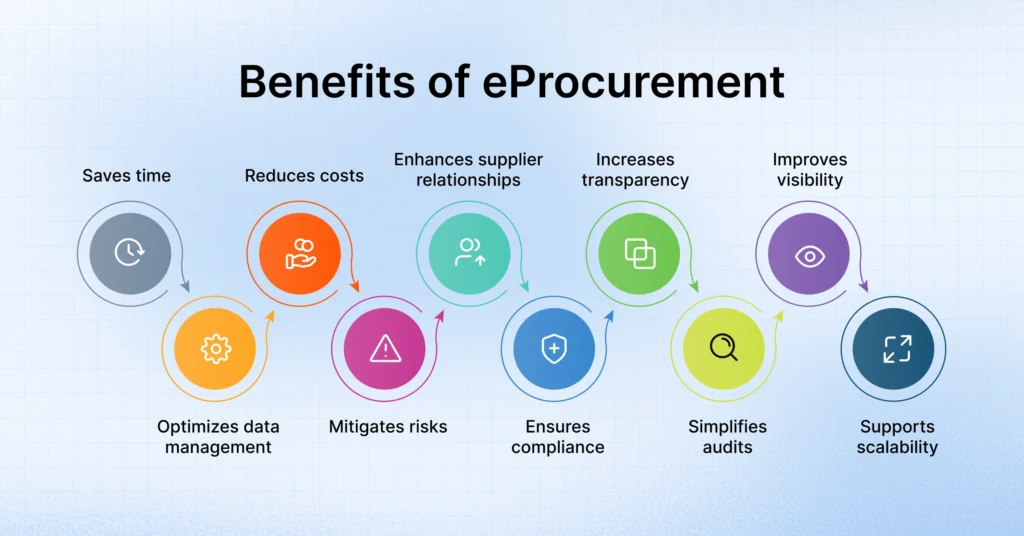
5. Improves visibility
With intuitive dashboards and real-time analytics, decision-makers gain instant insights into spending patterns, supplier status, and order progress for smarter actions.
6. Optimizes data management
E procurement technology collects, cleans, and organizes data using digital processes that reduce duplicate information. This enables teams to have access to all procurement documents.
7. Mitigates risks
With automated controls and standardized processes, eProcurement technologies ensure compliance with contracts and policies. This reduces the possibility of purchases being made outside the approved process, leading to costly mistakes.
8. Ensures compliance
The digital procurement process regularly enforces new policies and compliance rules that help businesses stay updated on changing trends and market rules. This is achieved through smart automation, which helps keep processes in check with government laws and reduces compliance issues.
9. Simplifies audits
With detailed records stored in a centralized system, procurement audit preparation is faster, more accurate, and hassle-free.
10. Supports scalability
Cloud-based platforms grow seamlessly with your organization. Digital tools can handle large volumes of data and adjust easily as your business expands, without the added hassle of maintenance and constant updates.
What are the steps involved in implementing an e-procurement strategy?
Starting an eProcurement strategy takes good research and careful planning. You need to first check your current process, set clear goals, involve key team members, choose the right tools, and track your progress throughout the P2P lifecycle. Here’s a brief explanation on how to do that.
1. Review your current process
Start by looking at how your company buys today. Find what works well and what slows things down.
- Who are your suppliers?
- How long does it take to get goods?
- What rules or checks are in place?
- How do you track spending?
2. Find gaps and problems
Next, point out the areas that slow processes down. These gaps show where you need to improve.
- Late deliveries or unreliable suppliers
- High costs or wasted spending
- Staff skipping rules
- Old tools or manual work
3. Involve stakeholders
Include everyone who will use or be affected by the new system. Having their opinion and input will make the change smoother.
- Finance team
- Department heads
- End users
- Key suppliers
4. Set goals and KPIs
Make a clear plan with goals and ways to measure success. Make sure these procurement KPIs align with your company’s bigger goals.
- Cut costs
- Reduce delays
- Improve supplier performance
- Increase compliance
5. Choose the right software
Pick a tool that fits your needs and connects with other business systems.
- Spend tracking and reports
- Vendor management
- Easy approvals and workflows
- Integration with ERP or accounting
6. Implement and review
Roll out the system carefully and give teams time to adjust. It’s best to see how the system works in phases before implementing it completely. Keep checking progress and improve where needed.
- Train staff and share updates
- Work with suppliers
- Track results against KPIs
What are the best practices for the eProcurement process?
Having the right software for e-procurement does help, but that’s not where it ends. A strong digital procurement process comprises having clear goals, stable policies, and the consent of all your teammates, using data to improve, and constantly monitoring your system and market trends to make sure you’re working to your full potential. Let’s explore some eProcurement applications that you can follow to ensure your process works the best it can.
1. Get everyone on board
Not everyone welcomes change with open arms. People need to be informed, trained, and heard for them to adapt. For e-procurement to work, the whole company should support it. Leaders, managers, and employees must all understand the benefits and be ready to use the system.
2. Set goals and rules for your processes
Start by looking at your current process and spotting problems. Then, set clear goals for what you want to achieve. These can be big or small goals, like saving time, reducing costs, or having a more sustainable budget. Create simple policies and approval steps so everyone follows the same rules.
3. Implement strategic sourcing
E-procurement consists of more than just buying. Choosing the right suppliers also matters. You need to examine what different suppliers are offering you and negotiate your terms accordingly. A pro tip is to upgrade your terms with every supplier you meet; that’s how you get the best deal. Choose partners aligned with your company goals. Strategic sourcing ensures efficiency, stronger relationships, and long-term value.
4. Review the whole process
E-procurement affects more than just the purchasing team. It involves finance, suppliers, and other departments as well. It’s important to review the entire purchase-to-pay cycle so the system helps the whole company, not just one part.
5. Use automation and integrate existing systems
Free up your employees by using automation to handle repetitive tasks. Instead of your employees creating invoices repeatedly over days and weeks, software can generate triple the amount in minutes. Additionally, ensure you connect your e-procurement software with tools like ERP or accounting systems so every department has access to data.
6. Digitize documentation and track performance
Keeping records digitally reduces errors. It also keeps all processes transparent and makes conducting a procurement audit easier. You should regularly monitor supplier performance and how your team is working internally to identify issues and optimize workflows accordingly.
7. Interact with all your suppliers and departments
Strong supplier relationships are key. Track their performance, share feedback on everything, even if it’s minor, and be open with them. You must also involve all departments in teams in your processes so that everyone feels like they’re contributing. And you never know, you may get valuable new outlooks.
8. Keep improving as you grow and stay ahead
Your setup is running smoothly, but don’t stop because of that. Check performance regularly, measure results, and compare them with where you were at the start. It’s also good to keep a track of risks like high costs, data problems, or supplier issues, and update your process to stay ahead.
Why Procol is the best eProcurement software solution
Procol is an AI-based eProcurement tool that makes buying easier for companies. With our solution, teams can cancel out the chaos and instead handle everything in one place, from sourcing and bids to orders, invoices, and contracts. This eliminates tedious manual work and prevents costly errors. Our automation puts all data and documents in a central system, so everyone can see the latest updates anytime. The tool also uses AI to create RFPs, predict spending, and check vendor performance, so companies can make faster and smarter choices.
Procol.io also offers vendor management features. Our intuitive and easily navigable vendor portal makes onboarding multiple suppliers simple. Businesses can also monitor their performance, check their quality, track their work, and reduce risks. The tool has analytics and reports that show spending trends and supplier performance. Additionally, since our platform is cloud-based and mobile-friendly, teams can use it anywhere. It also ensures data security, compliance, and easy ERP integration, so you’re fully equipped for all your procurement activities.
Conclusion
Now you know that there’s a lot of difference between chasing vendors through phone calls and tracking approvals on paper versus managing everything in one seamless platform. With eprocurement, late deliveries, hidden costs, and compliance risks turn into faster workflows, organized and transparent data, and stronger supplier relationships. Therefore, the businesses that choose digital procurement are doing more than just working smarter; they’re building an unbeatable foundation for growth in the procurement industry. AI-powered tools like Procol give your business the push you need to stay resilient and streamline procurement in the ever-competitive and changing world.
Frequently asked questions
What is the meaning of e-procurement?
The meaning of e-procurement refers to the online technology used to procure goods or services digitally through SaaS-based platforms.
What is e-procurement technology?
E-procurement technology uses electronic software and platforms to automate and manage the entire procurement process.
What is eProcurement software and how does it work?
eProcurement software is a digital tool that automates and centralizes procurement. It replaces manual tasks with web-based systems to streamline purchasing, approvals, and supplier management efficiently.
What is an example of an e-procurement system?
The top example of an e-procurement system is Procol, which automates the entire procure-to-pay process for businesses. The other well-known examples are Procurify, SAP Ariba, Coupa, JAGGAER, and GEP. These platforms automate purchasing, vendor onboarding, invoices, and spend tracking for businesses of all sizes.
How does eprocurement work?
eProcurement works by identifying needs, sourcing suppliers, negotiating contracts, and managing orders and transactions digitally. In short, it automates the entire P2P process so that operations are faster and more accurate.
Is eprocurement safe?
While there’s no definite answer, eProcurement safety depends on security measures. If systems are implemented and monitored properly, they protect against data breaches, fraud, and cyberattacks. This ensures that all digital payments are secure, vendor management is simple, and information remains confidential.
What is the best eProcurement software?
The best eProcurement software is Procol. Other popular names in the industry are Procurify, SAP Ariba, Coupa, JAGGAER, and GEP, catering to enterprises, small-to-medium businesses, higher education, government, and end-to-end source-to-pay needs.
Which organizations can gain the most from using eProcurement software?
Digital procurement benefits many industries. Large enterprises, manufacturing firms, public agencies, and industries like healthcare, education, retail, and hospitality benefit most. E-procurement helps improve process efficiency, helps them control costs, and enhances vendor management.
How does eProcurement software connect and work with ERP systems?
eProcurement integrates with ERP systems through APIs. This process involves synchronizing data, orders, approvals, and reporting. This helps streamline procurement and provide a navigable and unified view of all financial and operational documents.
In what ways can eProcurement software support compliance and manage risks?
eProcurement software enforces policies, centralizes data, automates workflows, and tracks supplier performance. This ensures that processes stay compliant, errors are minimized, and there are little to no operational and financial risks.
Explore more from Procol
Discover expert tips, how-to guides, industry insights, and the latest procurement trends.
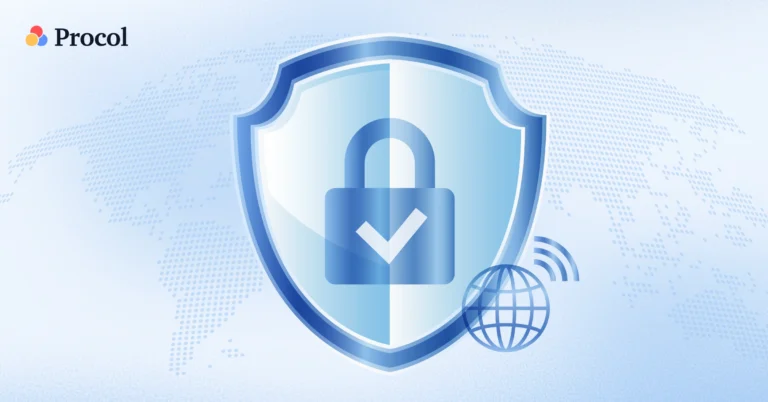
What is supply chain risk management (SCRM)? | Definition & steps
In an increasingly interconnected world, organizations rely on smooth supply chain...
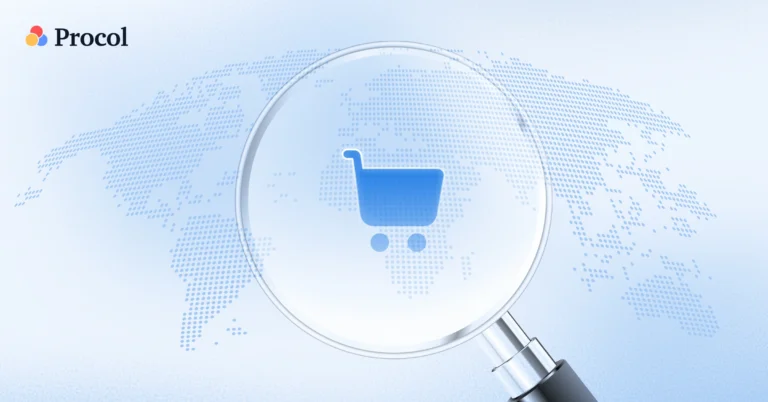
Strategic sourcing management software & sourcing solutions: a guide
Learn how strategic sourcing software helps optimize processes, key features and...
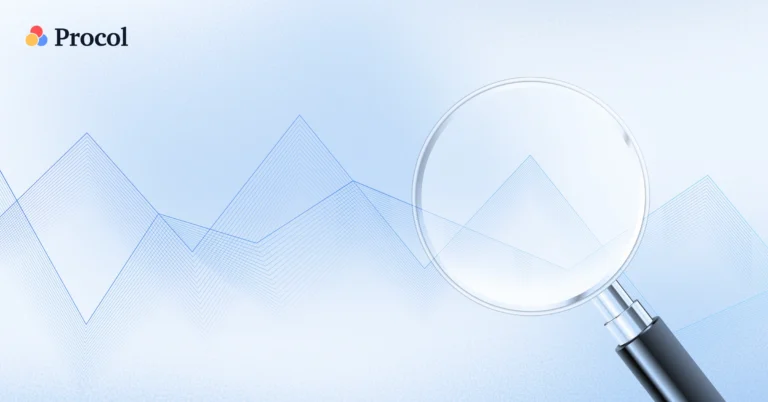
Sourcing strategies explained: Types, process, benefits, and examples
Sourcing strategies are important for creating effective, efficient, and resilient supply...
